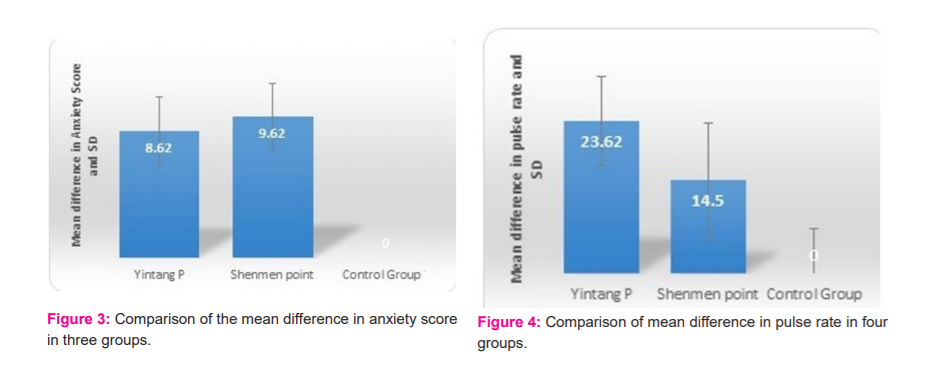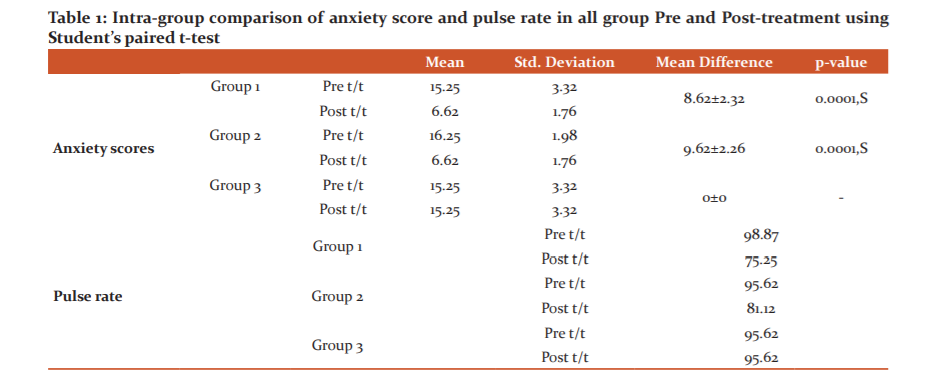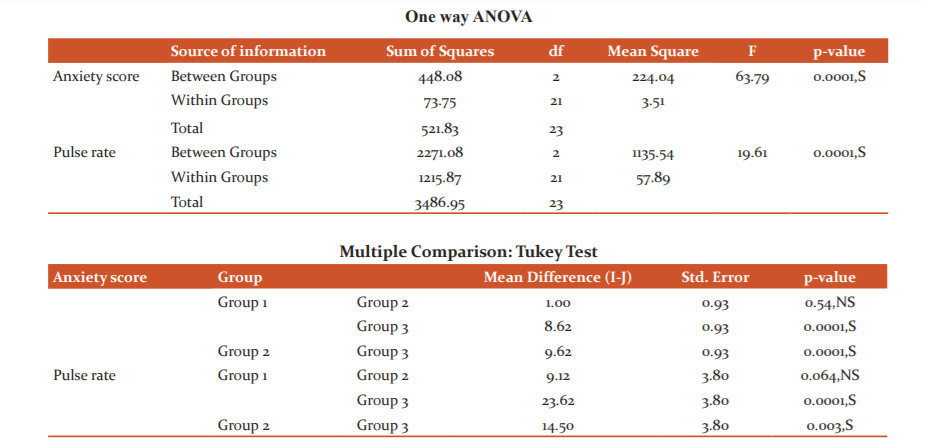IJCRR - 13(6), March, 2021
Pages: 101-106
Date of Publication: 20-Mar-2021
Print Article
Download XML Download PDF
Effect of Microcurrent Electrical Stimulation on Two Acupoints to Control Anxiety in Patients Receiving Prosthodontics Treatment
Author: Tanvi R. Balwani, Surekha Godbole Dubey
Category: Healthcare
Abstract:ntroduction: Dental fear is the most common issue which is present in patients. Therefore managing anxiety has become a task to achieve successful treatment. Therefore, dental anxiety is linked with an undesirable effect on oral health. Objective: To evaluate the effect of microcurrent electrical stimulation on two Acupoints i.e yintang and shamen points to control the level of anxiety amongst the patients. Methods: A total number of 30 patients who scored more than 10 in the MDAS questionnaire were enrolled in the study. Before commencing prosthodontic treatment procedures pulse oximeter and MDAS was used to assess anxiety levels. After which acupuncture and acupressure therapy was performed on acupoints using the acupuncture meridian pen. Treatment procedures were carried out after the therapy. The pre-treatment and post-treatment values were compared. Results: Acupuncture and acupressure performed at Bintang acupoint 8.62 \? 2.32 (mean\?SD) proved to be more effective compared to when men point 9.62\? 2.26 (mean\?SD). But when compared with the control group both the acupoints were effective in controlling anxiety levels. The decrease in anxiety levels was statistically significant(p< 0.001) when compared with the control group. Conclusion: Acupuncture and Acupressure performed at both the acupoint that is yintang and shenmen efficiently decreases anxiety before dental treatment. Acupuncture and Acupressure performed at both the acupoint that is yintang and shenmen could be a viable option in reducing anxiety levels in the patient receiving prosthodontics treatment. It improves the efficacy of treatment and also saves clinicians time. Moreover, the device used in the study is very effective and convenient to handle.
Keywords: Acupuncture, Anxiety, Novel Technique, Acupressure
Full Text:
INTRODUCTION
Dental fear is the most common issue which is present in patients. Therefore managing anxiety has become a task to achieve successful treatment. Therefore, dental anxiety is linked with an undesirable effect on oral health.1,2 Here are the number of treatment options that have come across for the treatment of dental anxiety. There is two treatment option which includes pharmacological and non-pharmacological methods. The use of Pharmacological methods although is effective but it also has its side effects. Due to which there is a high demand for non-pharmacological techniques.1 One of the recent technique for the management of anxiety disorders is the use of acupuncture and acupressure.
In the dental field, a study on adult populations reported a reduction in anxiety after acupuncture; another study proved this procedure to be as in effect as intranasal midazolam in decreasing anxiety in dental patients.2,3The constant need to incorporate alternative techniques into clinical dental practice led to the introduction of acupuncture, which is apart of ancient Chinese medicine. The technique is created upon the conception of Qi (whose pronunciation is “chee” meaning “life force, energy flow”), which states that most of the physical and emotional issues begin at a level of function that is subtler than the chemistry of the brain and organ function. The specific locations where this Qi gathers are termed acupoints, into which needles are put in to achieve numerous effects.4 This procedure has proven its effectiveness in the management of insomnia, asthma, general anxiety, and anxiety disorders.5-10
Acupuncture done by traditional method using needles can be traumatic for the patients. So by using microcurrent electrical stimulation, acupressure and acupuncture works by stimulating (tonify or sedate) specific reflex points which are present along the lines of energy that run through the body, called Meridians.12
This original research study aims to “Evaluate the effect of microcurrent electrical stimulation on two Acupoints that is yintang and shenmen points to control the level of anxiety amongst the patients”. In this original research study, a novel technique was used to control anxiety levels in patients receiving Prosthodontic treatment.
MATERIALS AND METHODS
Ethical clearance was obtained from the Ethics Committee of the university and performed at the Department of Prosthodontics And Crown & Bridge Sawangi Meghe Wardha.(DMIMS(DU)/IEC/2018-19/7633) A total of 30 patients were selected for the age group (18-45 years). They were planned for Prosthodontic treatment were performed. Patients were enrolled only after they gave written informed consent.
The inclusion and exclusion criteria were as follows:
-
Exclusion criteria included dental emergencies, ‘those who have experienced acupuncture, ‘language difficulties’, ‘history of drug abuse’, ‘chronic pain therapy’, ‘neurological or psychiatric disorders’, ‘malignomas’, ‘lesions at the external ear’, ‘immunosuppression’, ‘pregnancy’, ‘asthma and ‘coagulation disorders’.
-
Inclusion criteria were patients who fall under 10 to 25 score of modified dental anxiety scale, Patients who will give informed consent for the therapy, patients coming for prosthodontic treatment procedures, patients above the age of 18 years.
The patient was randomly divided into three groups 1, 2 and 3. Ten patients were present in each group. In all three groups, prosthodontics treatment procedures were done. Before and after which the Patient was selected based on the anxiety measuring scale and using a pulse oximeter, pulse rate, as well as oxygen saturation level, were evaluated before the patient underwent the therapy which was evaluated again after the therapy was done.
Modified Dental Anxiety Scale (MDAS) was used to assess the anxiety levels. It has a score of 0-25(not anxious to extremely anxious). In which Patient’s under fairly anxious to extremely anxious that is from score (10 to 25) anxiety scale were selected for the study.
Group 1 received electrical pulses at yintang anxiolytic point as shown in figure 1 (located midway between the medial ends of the two eyebrows) using a laser acupuncture pen. This pen automatically searches the site, no piercing of the skin is done, it is safe and effective with no side effects. It has 9 intensity levels so a mild range level that is up to 3 intensity level was used in the patients. After this using Pulse oximeter, pulse rate and oxygen saturation levels were checked pre-treatment and post-treatment. Levels of pulse rate and oxygen saturation helped to evaluate whether there is a reduction in anxiety level amongst the patients.
Group 2 received microcurrent electrical pulses to stimulate anxiolytic points the auricular Shen Men point as shown in figure 2(located at lateral third of the triangular fossa, in the bifurcating point between superior and inferior crura of antihelix)
Group 3 was the placebo group, received microcurrent electrical pulses on point not documented to reduce anxiety (located on the forehead above the eyebrows 3 cuns aways from yintang point). The placebo point was selected different from yintang point and Shenmen point to check the efficacy of microcurrent stimulation using a laser acupuncture pen on a point that is different from an acupuncture point which does not have any anti-anxiety effect. For all the patients in treatment groups, a self-report measure of anxiety (MDAS) was recorded 40 minutes before starting the treatment.1 Those receiving microcurrent electrical stimulation at the selected acupoints were held passively every 3 minutes for approximately 10 minutes.1
After completion of the intended treatment, Modified Dental Anxiety Scale (MDAS) scores were recorded again. All the variations in the pulse rate, beginning with 40 minutes before starting the treatment to 15 minutes post-treatment, were recorded.1 With the help of the anxiety measuring scale before and after values were compared. Based on which it was concluded that microcurrent electrical stimulation is effective in reducing Anxiety. RESULTS
Statistical analysis was done by using descriptive and inferential statistics using one way ANOVA and Multiple comparisons: Tukey test and software used in the analysis was SPSS 22.0 version and p<0.05 is considered as the level of significance. On Intragroup comparison the anxiety and pulse rate scores of group 1,2 and 3 are presented in Table 1. Statistically significant data was observed in group 1 and Group 2 (p<0.05) (Table 1).According to which graph 1 and graph 2 depicts there is a significant difference in mean anxiety scores pre-treatment and post-treatment in both yintang group and shenmen group. The oxygen saturation levels were unchanged for all the groups (Figure 1).
On intergroup comparison, mean values of anxiety scores and pulse rate among three groups 1, 2, 3 after the procedure were statistically significant at group 1 and 2 (p<0.05) (Table 2). In the comparison of the mean values of anxiety scores and pulse rate with all the three groups after the procedure, it was observed that mean values are not reduced in group 3 (Table 2). When multiple comparisons were done using the Tukey test the mean values anxiety scores and pulse rate scores were compared among three groups 1, 2, 3 after the procedure, results were statistically significant between-group 1 and group 3. And also between group 2 and group 3(p<0.05). The average improvement for the reduction in anxiety score was highest in Group 1 (Figures 2 and 3). The average improvement for the reduction in pulse rate score was highest in Group 2 (Figure 4).
DISCUSSION
Anxiety is a serious issue and managing such a patient has become a prime requisite. The treatment procedure can become difficult to do if the patient is suffering from anxiety issues. Various methods are there to control anxiety levels.1 In this original research study a novel technique has been used which has significantly reduced anxiety levels in patients who came for treatment. This technique demonstrates that acupuncture and acupressure using micro-current electrical stimulation of the outer ear that is shenmen point and yintang point efficiently decreases anxiety before the beginning of the prosthodontic treatment with minimal side effects.
Other studies which stated the effectivity of acupuncture and acupressure are Sauberer.12 stated that acupuncture performed at shenmen acupoint is a negligibly invasive technique that efficiently reduced anxiety before initiating the treatment. Avisa1 proved that the difference in the MCDAS, pulse rate and behaviour rating scale amongst the 3 children groups was significant. And the group who received acupressure displayed the lowest level of anxiety. This study proved that acupressure can be a feasible treatment option in managing anxiety. Carvalho13 study was on PMDD in which evaluation was done on the effects of two groups. Firstly the group received acupuncture and the other one was sham acupuncture. This study proved that acupuncture can be a viable option for premenstrual dysphoric disorder (PMDD). Singla14 et al. conducted a study in the unsedated pediatric dental patients in whom evaluation of changes in pulse rate and SPO2 levels was done. It was observed that intraoperative pulse rate values increased when compared with the starting point values. And it dropped in the postoperatively. It was observed it various studies that SPO2 values remained altered.
The effect of microcurrent electrical stimulation was evaluated in this study on yintnag point, shenmen point and placebo point. The reason for the usage of both yintang point and shenmen point was to investigate whether the two points have a synergistic effect. Microcurrent electrical stimulation at acupoints was held passively every 3 minutes for approximately 10 minutes which effectively reduced anxiety. It was observed that anxiety levels increased immediately before commencing treatment in the control group. It was assessed with MDAS and Pulse oximeter. And then comparison was done between the control group and group receiving Microcurrent electrical stimulation.
Significant reduction in anxiety reflex in group 1 and group 2 was observed (p<0.05). Although on intragroup comparison in groups 1 and 2, mean values of anxiety and pulse rate scores were less post-treatment. A statistically significant difference between group 3 was not observed (Table 1). On intergroup comparison, there was a statistically significant difference found between group 2 and group 3 as well as between group 1 and group 3 (Graph 1,2). No correlation was found between group 1 and group 2. A pulse oximeter was used to accurately assess the pulse rate as well as oxygen saturation levels of the patients. In this study pulse rate reduced both in group 1 and group 2. But oxygen saturation levels were unaltered as observed in other studies as well.
Acupuncture has been postulated to produce low-frequency electrical stimulation of the skin sensory receptors that cause the release of endorphins from the hypothalamus. This theory has been substantiated by a study, which reported increased levels of β endorphin concentration in human cerebrospinal fluid after acupuncture stimulation. Other hypothesized mechanisms include simulation causing the release of neuropeptide-induced anti-inflammatory cytokines; altering brain neurotransmitters, such as serotonin, that play a key role in determining emotional states; hormonal regulation; release of certain peptides with an analgesic effect; reduction in the activation of the sympathoadrenal system; activation of small myelinated nerve fibres that send impulses into the spinal cord, midbrain, pituitary, and hypothalamus, causing the release of endorphins into the blood; and interruption of incoming stress signals in the central nervous system by neurotransmitters, such as serotonin, norepinephrine, and aminobutyric acid.15,16,17 It can be hypothesized that the same mechanisms are applicable for microcurrent electrical stimulation at acupoints, as it is a non-invasive variant of acupuncture wherein microcurrent electrical stimulation is applied on acupoints using a laser acupuncture pen, instead of puncturing the points with needles.12
CONCLUSION
Based on this original research study following conclusions can be drawn:
1) Acupuncture and acupressure performed using microcurrent electrical stimulations has a significant role in reducing anxiety levels amongst patients.
2) Two acupoint yintang and shenmen points both are effective in reducing anxiety levels amongst the patients.
3) Acupuncture meridian pen has been proven to be very effective to be used in reducing anxiety levels in patients.
CONFLICT OF INTEREST: Nil
SOURCE OF FUNDING: Nil
ACKNOWLEDGEMENT: The authors acknowledge the immense help received from the scholars whose articles are cited and included in the reference text. The authors are also grateful to authors/ editors/ publishers of all the articles, journals and books from where the literature of this article has been reviewed and discussed.






References:
-
Avisa P, Kamatham R, Vanjari K, Nuvvula S. Effectiveness of acupressure on dental anxiety in children. Pediatr Dent 2018;40(3):177-183.
-
Gondivkar SM, Bhowate RR, Gadbail AR, Gondivkar RS, Sarode SC, Sarode GS, et al. Impact of oral submucous fibrosis on oral health?related quality of life: A condition?specific OHRQ oL?OSF instrument analysis. Oral Dis 2018;24(8):1442-1448.
-
Karst M, Winterhalter M, Münte S, Francki B, Hondronikos A, Eckardt A, et al. Auricular acupuncture for dental anxiety: a randomized controlled trial. Anesth Analg. 2007;104(2):295-300.
-
Rosted P, Bundgaard M, Gordon S, Pedersen AM. Acupuncture in the management of anxiety related to dental treatment: a case series. Accupun Med 2010;28(1):3-5.
-
Ramey D, Buell PD. A true history of acupuncture. Focus on Alternative and Complementary Therapies. Acupun Med 2004;9(4):269-73.
-
Spence DW, Kayumov L, Chen A, Lowe A, Jain U, Katzman MA, et al. Acupuncture increases nocturnal melatonin secretion and reduces insomnia and anxiety: a preliminary report. J Neuropsy Clin Neurosci 2004;16(1):19-28.
-
Liu CF, Chien LW. Efficacy of acupuncture in children with asthma: a systematic review. Ital J Ped 2015;41(1):48.
-
Pilkington K, Kirkwood G, Rampes H, Cummings M, Richardson J. Acupuncture for anxiety and anxiety disorders–a systematic literature review. Acup Med 2007;25(1-2):1-10.
-
Wang SM, Kain ZN. Auricular acupuncture: a potential treatment for anxiety. Anesth Analg 2001;92(2):548-553.
-
Bussell J. Acupuncture and anxiety 2013: the year in (literature) review. Altern Med 2014;2(1):3.
-
Errington?Evans N. Acupuncture for anxiety. CNS Neurosci Therap 2012;18(4):277-284.
-
Raghavan R, Sathish S. Acupuncture in prosthodontics. Guident 2016;9(3).
-
Carvalho F, Weires K, Ebling M, de Souza Rabbo Padilha M, Ferrão YA, Vercelino R. Effects of acupuncture on the symptoms of anxiety and depression caused by the premenstrual dysphoric disorder. Acupun Med 2013;31(4):358-363.
-
Singla D, Anand A, Dharma P, Sharma A. Evaluation Of Pulse Rate And Arterial Oxygen Saturation (Sa02) Levels In Children During Routine Dental Procedures. J Den Speci 2013;1(2):27-34
-
Khanam N, Wagh V, Gaidhane AM, Quazi SZ. Assessment of work-related musculoskeletal morbidity, perceived causes and preventive activities practised reducing morbidity among brick field workers. Ind J Comm Health 2019;31(2):462-468.
-
Khandelwal V, Gupta N, Nayak UA, Kulshreshtha N, Baliga S. Knowledge of hepatitis B virus infection and its control practices among dental students in an Indian city. Int J Adol Med Health 2017 Aug 18;30(5): 1089-1091.
-
Tripathi A, Avasthi A, Grover S, Sharma E, Lakdawala BM, Thirunavukarasu M, et al. Gender Differences in Obsessive-Compulsive Disorder: Findings from a Multicentric Study from Northern India. Asian J Psychol 2018:37:3–9.
|






 This work is licensed under a Creative Commons Attribution-NonCommercial 4.0 International License
This work is licensed under a Creative Commons Attribution-NonCommercial 4.0 International License